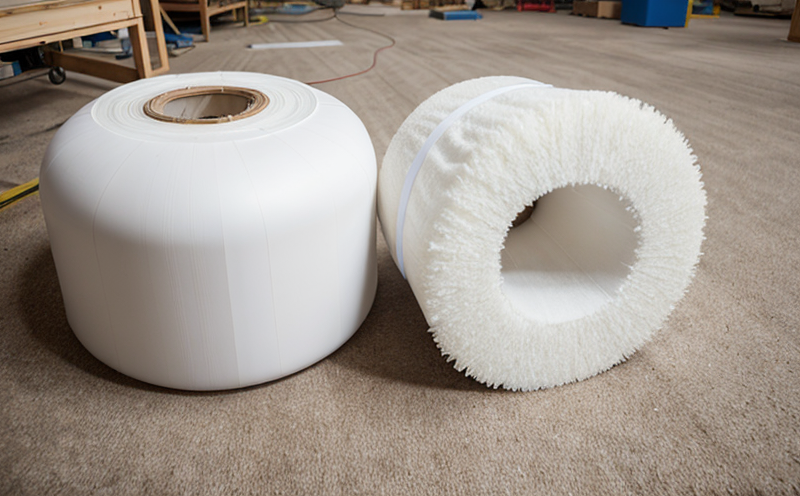ASTM E492 Impact Sound Transmission Testing
The ASTM E492 standard describes procedures for measuring the impact sound insulation performance of building materials and assemblies. This testing method is widely used to evaluate the ability of materials or constructions to attenuate impact noise transmitted through floors, walls, partitions, and roofs.
Impact sound transmission testing aims at quantifying the reduction in sound energy that passes through a partition due to human activities such as walking, dropping objects, or other impacts. The test is particularly relevant for residential buildings where the comfort of occupants can be significantly affected by noise from adjacent spaces.
The ASTM E492 procedure involves placing a standard tapping machine on one side of the partition and measuring the impact sound level (IL) in both the transmitting and receiving rooms using microphones. The ILs are then used to calculate the weighted normalized impact insulation class (IC) or impact noise rating (NRC).
The testing setup typically includes a standard tapping machine, microphones mounted on sound-attenuating pads, and an appropriate partition under test. The tapping machine is placed directly onto the surface of the partition in the transmitting room, while microphones are positioned according to specific guidelines.
The specimen preparation for ASTM E492 testing involves ensuring that the partition meets certain criteria regarding thickness, material composition, and finish. For composite partitions, it's essential to define the test location as either the inner or outer leaf of the construction.
Once the setup is complete, tapping machine strikes are delivered at a specified rate and force. The transmitted sound levels in both rooms are recorded, and the results are processed according to the ASTM E492 formulae to calculate the IC values for the tested partition.
The testing procedure also specifies the conditions under which the test should be conducted, such as room acoustics, temperature, and humidity. Compliance with these conditions ensures that the results accurately reflect the performance of the partition material or construction under typical use conditions.
Impact sound transmission tests are crucial for architects, builders, and acoustic consultants in designing buildings to meet regulatory requirements and customer expectations regarding noise control. The test results provide valuable data for ongoing research and development efforts aimed at improving sound insulation materials and constructions.
Applied Standards
The ASTM E492 standard is widely recognized in the construction industry, particularly for evaluating the impact sound performance of floor assemblies. This standard has been adopted by various countries and organizations around the world to ensure consistent testing procedures and comparable results.
Apart from ASTM E492, other relevant standards include ISO 140-5, which provides a framework for specifying requirements, test methods, and performance criteria for impact sound insulation. EN 13763-5 also offers similar specifications for floor constructions in buildings.
These international standards are crucial because they provide harmonized guidelines that facilitate global trade and ensure that products meet the same performance levels across different countries. Compliance with these standards is often a requirement for certification, product approval, or regulatory compliance.
Quality and Reliability Assurance
The quality and reliability assurance of ASTM E492 impact sound transmission testing are paramount to ensure the accuracy and repeatability of test results. Proper calibration of all instruments is critical, including tapping machines, microphones, and noise level meters. The use of certified reference materials can also enhance the precision of measurements.
Training for personnel involved in conducting these tests should be comprehensive and ongoing to ensure consistent application of the standard procedures. Regular audits of testing laboratories and equipment calibration are essential to maintain high standards of quality assurance.
In addition, maintaining a clean and controlled environment during testing helps avoid external noise interference that could skew results. The use of appropriate soundproofing materials in test rooms further ensures accurate measurements by minimizing unwanted ambient noise.
Use Cases and Application Examples
The ASTM E492 impact sound transmission testing is widely used in various sectors, including residential buildings, commercial spaces, and public facilities. In residential settings, this test ensures that floors do not transmit excessive noise from one room to another or from the upper floor to the lower.
In commercial applications, such as offices and retail spaces, the test helps mitigate noise pollution by ensuring partitions between different areas are effective in reducing sound transmission. Public facilities like schools and hospitals benefit significantly from this testing to maintain a quiet environment conducive to learning and recovery.
For architects and engineers designing new buildings or renovating existing ones, ASTM E492 provides critical data for selecting appropriate materials and constructions that meet the required noise insulation standards. This ensures that building occupants experience a more comfortable and quieter living or working space.





